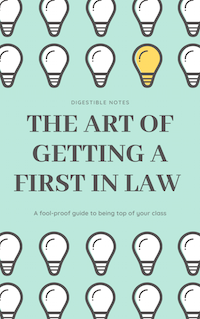Criminal Causation
Introduction to Criminal Causation
⇒ Causation refers to the enquiry as to whether the defendant's conduct (or omission) caused the harm or damage.
⇒ Usually it is easy to established whether the defendant has caused the harm/damage. In other words, as the court said in R v Kennedy, it is usually “common sense”.
⇒ However, sometimes it can be more difficult to establish whether the defendant has caused the harm/damage. In this situation the judge will direct the jury to apply special legal rules → they will look at factual and legal causation (see below).
⇒ Factual causation is the starting point and consists of applying the 'but for' test.
Factual / 'But for' causation
⇒ Factual causation is established by applying the 'but for' test. This asks, 'but for the actions of the defendant, would the result/consequences have occurred?'
- So there must be a factual link between the defendant and the harm caused.
⇒ See, for example, the cases of R v Dyson and R v White. In R v Dyson, the defendant could be said to have caused the victim’s death, whereas in R v White the defendant could not be said to have been the factual cause of the victim’s death.
⇒ Establishing factual causation is not enough, as it is too wide: it would be absurd, for instance, to argue ‘but for the defendant’s parents giving birth to him/her, the defendant would not have killed the victim’ and, therefore, find the defendant’s parents criminally liable. Thus, we must also establish legal causation.
Legal Causation
⇒ Having established causation in fact it is also necessary to establish causation in law. Causation in fact does not always mean there will be causation in law.
⇒ Causation in law can be established by showing that the defendant's act was an ‘operating and substantial' cause of the consequence and that there was no intervening event.
⇒ A substantial cause: the defendant’s acts must be a significant factor in the final consequence/result i.e. the defendant’s acts must be more than an “insubstantial or insignificant contribution”.
⇒ An operating cause: the defendant’s acts need not be the sole or even the main factor in the final consequence/result. See, for example, R v Benge.
The Art of Getting a First in Law - ONLY £4.99
FOOL-PROOF methods of obtaining top grades
SECRETS your professors won't tell you and your peers don't know
INSIDER TIPS and tricks so you can spend less time studying and land the perfect job
We work really hard to provide you with incredible law notes for free...
The proceeds of this eBook helps us to run the site and keep the service FREE!

Third party acts breaking the chain of causation (Novus actus interveniens)
⇒ A novus actus interveniens is an act or event that breaks the causal connection between a wrong or crime committed by the defendant and the final consequence/result.
⇒ Thus, if the defendant is able to demonstrate a valid novus actus interveniens, this will be evidence that he/she did not cause the crime, and therefore will not be criminally liable.
⇒ R v Kennedy confirmed a key principle in this area of law: where the defendant does an act, and there is a subsequent (possibly intervening) act by X, X’s act will be a novus actus interveniens where it is:
- A free, voluntary, and informed act; and
- It renders the defendant’ act no longer a substantial and operating cause.
⇒ X’s act will not be free, voluntary, or informed if there is a justification behind the act: for example, if you throw a rock at Sally’s head and Sally deflects it to protect herself, but the rock flies off an hits Henry, you will still be said to have caused Henry’s injuries. There was no novus actus interveniens as Sally’s actions - in deflecting the rock - were justified.
⇒ More cases on this: R v Pagett, R v Malcherek & Steel, R v Jordan, and R v Cheshire.
Third party omissions breaking the chain of causation
⇒ As a general rule, it would seem that omissions of a third party cannot break the chain of causation. For example, if you stabbed someone and a medic arrived but refused to treat the victim, the medic’s omission (to treat the victim) would not break the chain of causation.
The victim’s acts breaking the chain of causation
⇒ An act of the victim will not break the chain of causation unless the victim’s actions were unreasonable and disproportionate in the circumstances.
⇒ For instance, if a defendant stabbed the victim on the toe and the victim, in pain, decided to stab himself in the chest because he would rather die than put up with the pain this would break the chain of causation
- The victim's actions here would clearly be unreasonable and disproportionate to justify giving the defendant a murder/manslaughter sentence.
⇒ See, for example, the case of R v Blaue.
The ‘thin skull’ rule (or egg shell skull rule)
⇒ The 'thin skull' rule says that the defendant must take his victim as he finds him. Therefore, even if injury or death is not reasonably foreseeable the law still considers the defendant liable if the victim suffered from some physical or mental condition that made him or her vulnerable. See, for example, the case of R v Hayward.
Act of God
⇒ It is possible that the chain of causation might be broken by a completely external occurrence or factor which is really a coincidence. Obviously such occurrences are very rare.
Law Application Masterclass - ONLY £9.99
Learn how to effortlessly land vacation schemes, training contracts, and pupillages by making your law applications awesome. This eBook is constructed by lawyers and recruiters from the world's leading law firms and barristers' chambers.
✅ 60+ page eBook
✅ Research Methods, Success Secrets, Tips, Tricks, and more!
✅ Help keep Digestible Notes FREE

